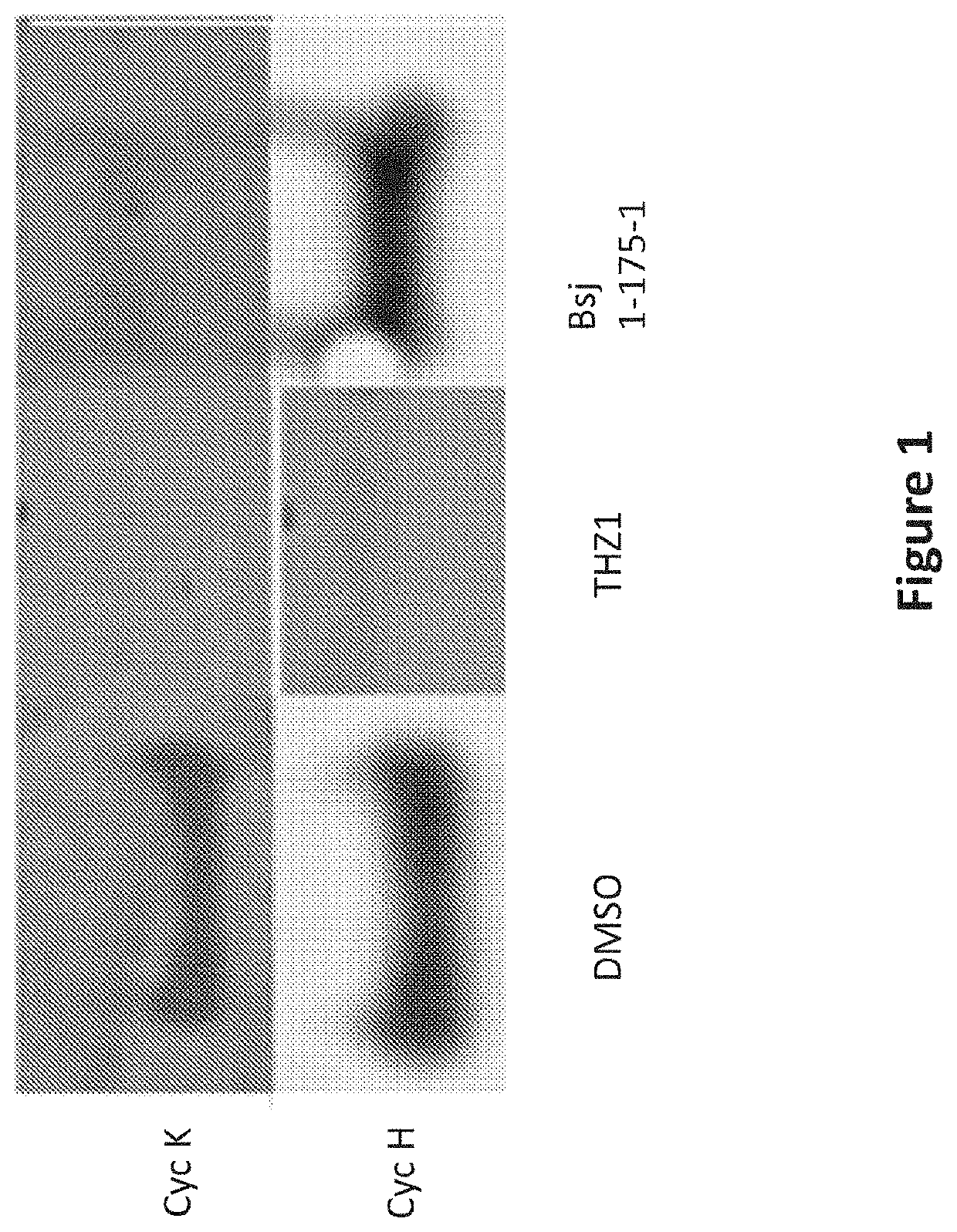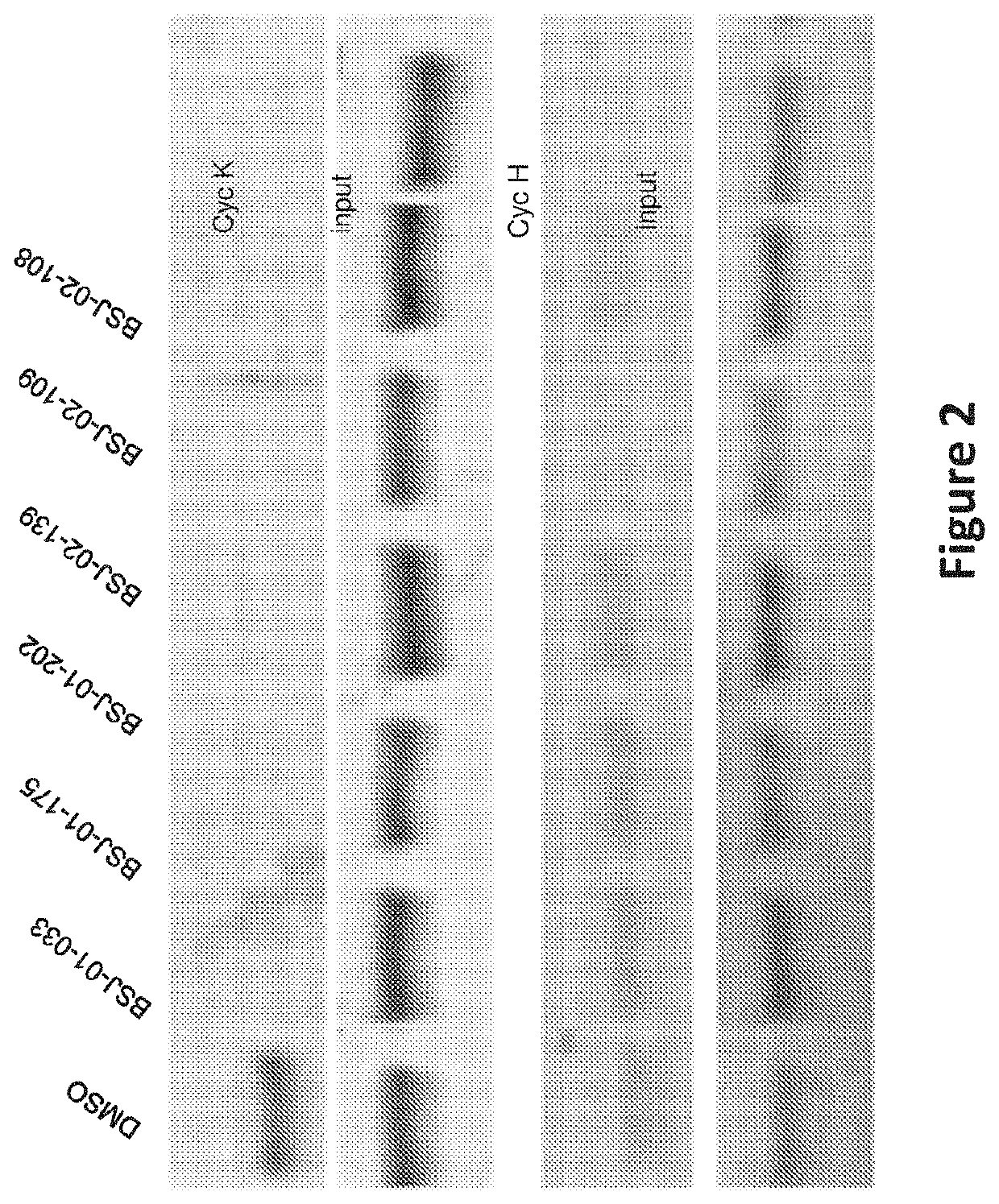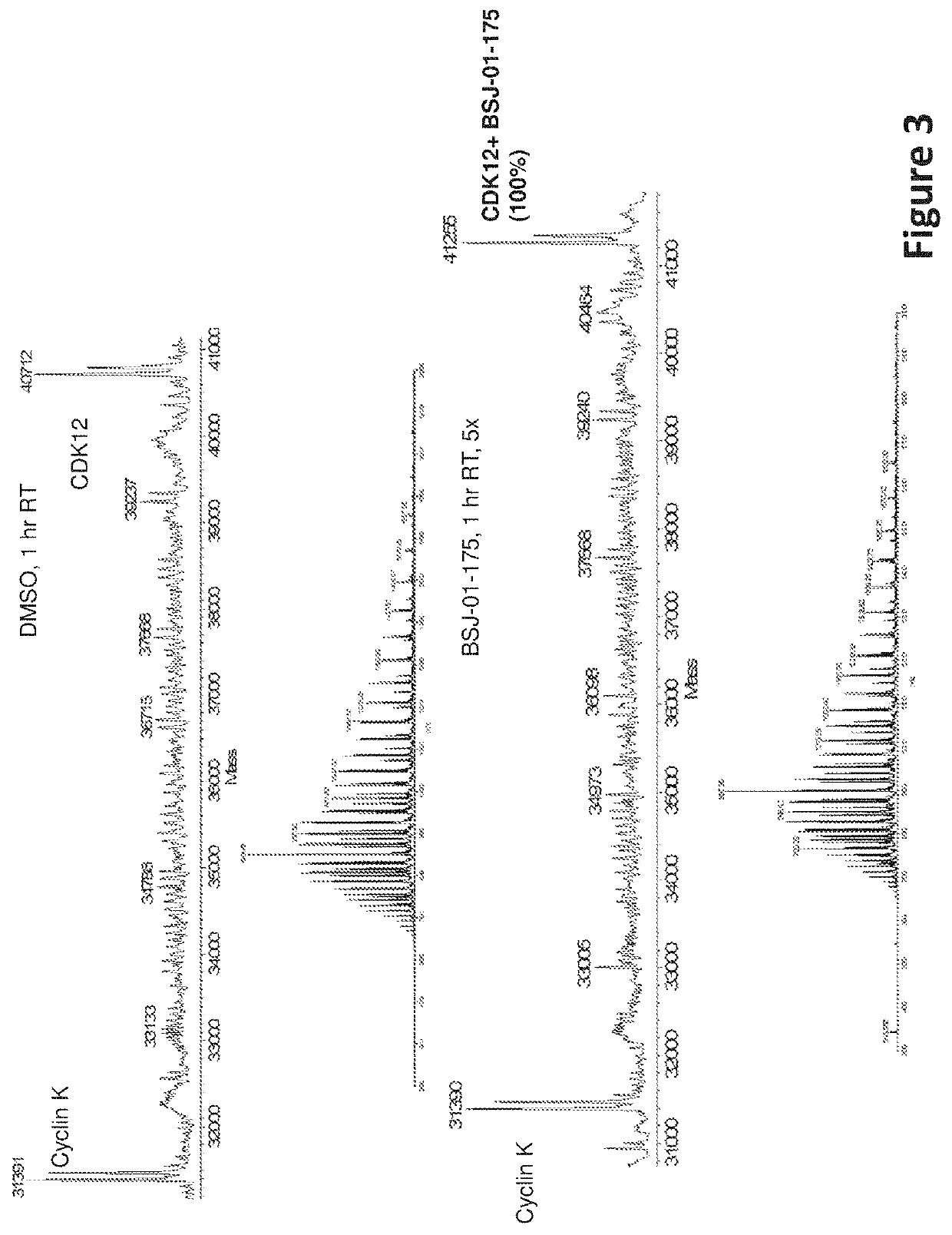Inhibitors of cyclin-dependent kinase 12 (CDK12) and uses thereof
- Summary
- Abstract
- Description
- Claims
- Application Information
AI Technical Summary
Benefits of technology
Problems solved by technology
Method used
Image
Examples
example 1
of N-(4-((1R,3R)-3-(5-chloro-4-(1H-indol-3-yl)pyrimidin-2-ylamino)cyclohexyloxy)phenyl)acrylamide (BSJ-01-033)
[0385]
(1R,3R)-3-(4-nitrophenoxy)cyclohexanamine
[0386]
[0387]To a suspension of NaH (0.8 g, 8.25 mmol) in 3.0 mL of anhydrous DMF was added (1R,3R)-3-aminocyclohexanol HCl salt (0.5 g, 3.3 mmol) slowly at 0° C. and kept stirring for 0.5 h, then 1-fluoro-4-nitrobenzene (0.465 g, 3.3 mmol) was added. The reaction mixture was kept stirring at 0° C. for another 0.5 h, then warm to room temperature and kept stirring for 2 h. 1.0 mL of H2O was added dropwise to quench the reaction. The mixture was extracted with DCM (100 mL), washed with brine (3×50 mL), dried (anhydrous Na2SO4), filtered and concentrated under reduced pressure. The residue was purified by chromatography on silica gel to give the title compound (623 mg, 80%) as a brown solid. LC-MS (m / z): 237 [M+H]+.
5-chloro-N-((1R,3R)-3-(4-nitrophenoxy)cyclohexyl)-4-(1-(phenylsulfonyl)-1H-indol-3-yl)pyrimidin-2-amine
[0388]
[0389]3-(...
example 2
of (E)-N-(4-((1R,3R)-3-(5-chloro-4-(1H-indol-3-yl)pyrimidin-2-ylamino)cyclohexyloxy)phenyl)-4-(dimethylamino)but-2-enamide (BSJ-01-175)
[0396]
[0397]To a cold solution (0° C.) of N-((1R,3R)-3-(4-aminophenoxy)cyclohexyl)-5-chloro-4-(1H-indol-3-yl)pyrimidin-2-amine (15 mg, 0.035 mmol) and 0.1 mL of DIPEA in 2.0 mL of anhydrous CH3CN was added a solution of (E)-4-bromobut-2-enoyl chloride (6.34 mg, 0.035 mmol) in 1.0 mL of DCM dropwise. After 0.5 h at 0° C., a 2M solution of dimethylamine in THF (1.0 mL) was added and the mixture was stirred for 1 h at 0° C. Then 1.5 mL of DMSO was added, followed by removal of the low boiling point solvents under reduced pressure. The residue was purified by prep-HPLC (MeOH / H2O, 0.05% TFA) to give the title compound (11 mg, 58%) as a light yellow solid after lyophilisation. LC-MS (m / z): 545 [M+H]+. 1H NMR (500 MHz, DMSO-d6) δ 10.92 (dd, J=10.4, 5.6 Hz, 1H), 10.38 (s, 1H), 8.65 (d, J=8.4 Hz, 2H), 8.36 (s, 1H), 7.59 (d, J=8.7 Hz, 2H), 7.54 (d, J=8.1 Hz, 1...
example 3
of (E)-N-(4-(3-(5-chloro-4-(1H-indol-3-yl)pyrimidin-2-ylamino)cyclohexyloxy)phenyl)-4-(dimethylamino)but-2-enamide (BSJ-01-193)
[0398]
3-(4-nitrophenoxy)cyclohexanamine
[0399]
[0400]To a suspension of NaH (0.8 g, 8.25 mmol) in 3.0 mL of anhydrous DMF was added 3-aminocyclohexanol HCl salt (0.5 g, 3.3 mmol) slowly at 0° C. and kept stirring for 0.5 h, then 1-fluoro-4-nitrobenzene (0.465 g, 3.3 mmol) was added. The reaction mixture was kept stirring at 0° C. for another 0.5 h, then warm to room temperature and kept stirring for 2 h. 1.0 mL of H2O was added dropwise to quench the reaction. The mixture was extracted with DCM (100 mL), washed with brine (3×50 mL), dried (anhydrous Na2SO4), filtered and concentrated under reduced pressure. The residue was purified by chromatography on silica gel to give the title compound (623 mg, 80%) as a brown solid. LC-MS (m / z): 237 [M+H]+.
5-chloro-N-(3-(4-nitrophenoxy)cyclohexyl)-4-(1-(phenylsulfonyl)-1H-indol-3-yl)pyrimidin-2-amine
[0401]
[0402]3-(2,5-dic...
PUM
 Login to View More
Login to View More Abstract
Description
Claims
Application Information
 Login to View More
Login to View More - R&D
- Intellectual Property
- Life Sciences
- Materials
- Tech Scout
- Unparalleled Data Quality
- Higher Quality Content
- 60% Fewer Hallucinations
Browse by: Latest US Patents, China's latest patents, Technical Efficacy Thesaurus, Application Domain, Technology Topic, Popular Technical Reports.
© 2025 PatSnap. All rights reserved.Legal|Privacy policy|Modern Slavery Act Transparency Statement|Sitemap|About US| Contact US: help@patsnap.com



